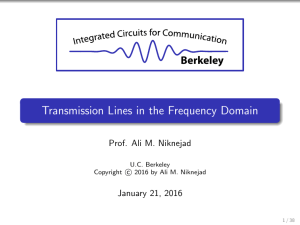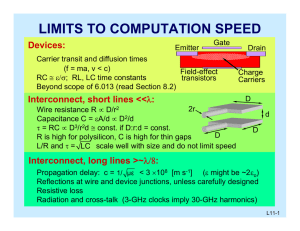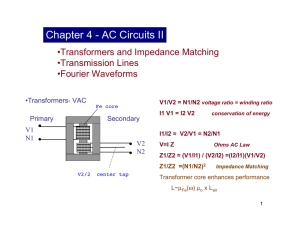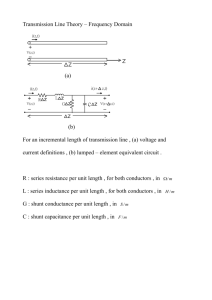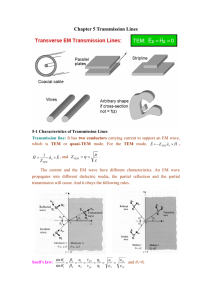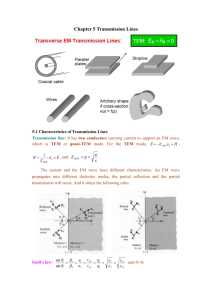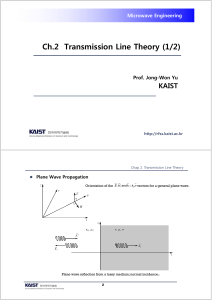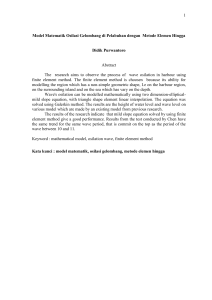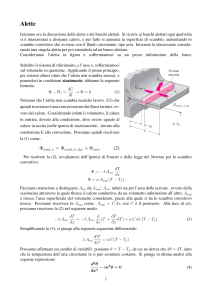Document
advertisement
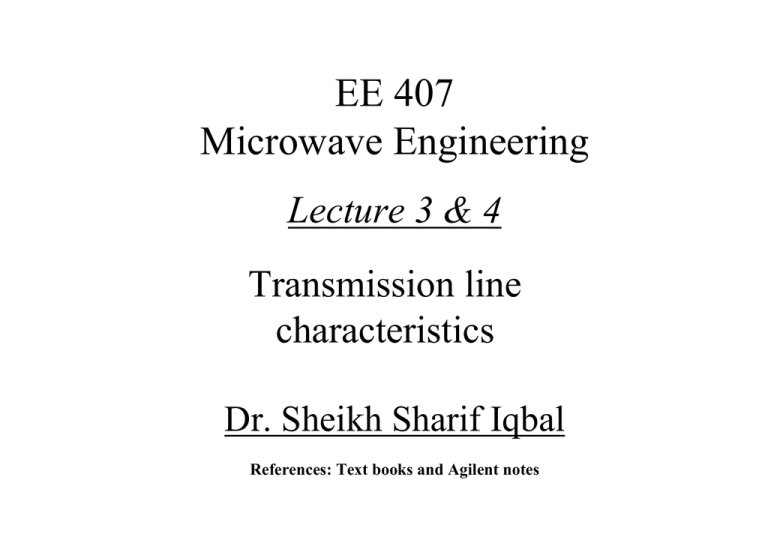
EE 407
Microwave Engineering
Lecture 3 & 4
Transmission line
characteristics
Dr. Sheikh Sharif Iqbal
References: Text books and Agilent notes
Behavior of basic Transmission media:
•At low frequencies: TL is considered to be a short wire with a negligible
distributed resistance, represented as lumped for the purpose of analysis.
V1=V2+IR
• At high frequencies: analyzed by M.E’s or distributed circuit model;
Z=R+jωL
Y=G+jωC
V(z,t)
Z
V(z+∆z,t)
∆z
• dV/dz = -ZI and dI/dz = -YV ; where ‘Z’ & ‘Y’ are function of frequency
• Here, ‘Z’& ‘Y’ are function of frequency only and ∆Z → 0;.
dV/dz = -Z I
(eq. 1)
dI/dz = -Y V ;
•Differentiating again gives: {as ZÎ Z(f)}
(eq. 2)
d2V/dz2 = -Z. dI/dz = ZYV
d2I/dz2 = -Y.dV/dz = YZI
• If no reflected wave is present;
V = V(z,t) = V0+ ejωt-γz and
I = I(z,t) = I0+ ejωt-γz
and
V+ = V(z) = V0+ e-γz
I+ = I(z) = I0+ e-γz
(eq. 3)
• Substitute V(z,t) and I(z,t) into eq.2 and differentiating yields:
γ2 V0+ ejωt-γz = Z Y V0+ ejωt-γz
(eq. 4)
γ = ±√ZY
γ = ±√(R+jωL)(G+jωC) ≡> called Propagation Constant.
Again, γ ≡ α+jβ, where α=attenuation cons & β=phase cons=2π/λ.
•Substituting V(z,t) and I(z,t) into eq.1 gives:
− γ V 0+ e jω t − γz = − Z I 0+ e jω t − γz
V 0+ Z
Z
R + jω L
= =±
=±
+
I0
γ
Y
G + jω C
V 0+
= Z0 = ±
Again,
+
I0
R + jω L
G + jω C
•Note: ‘+’ & ‘-’ is used for observer looking into the ‘load’ & ‘generator’
Infinitely long Transmission Line (or ZL=Z0):
• If ‘ZL= Z0’of TL ⇒ Matched ⇒ No reflection occurs ⇒ ≈ infinite line
• Time-average incident power & loss/length alone the line (if ‘Z0’ is real)
[
]
2
V0+ − 2 αz
1
+
+
+
*
P (z) = ReV ( z ) V ( z ) =
e
2
2Z 0
− ∆P / ∆Z − (P2 − P1 ) / d
α=
=
2P
2 P1
Mismatched Transmission Line (ZL≠Z0):
• If ZL= ∞; when incident wave arrive at the O/C end, it must satisfy ;
(1) For the traveling wave: V+/I+ = V-/I- = Z0 of the transmission line
(2) Ohm’s law at O/C requires an infinite impedance as current is zero
• Creation of reflected waves (V-, I-) satisfies both requirements.
• Thus at any pt.of TL, V(z)= V0+e-γz + V0- eγz = V++ V- and I(z) = I+- I•Load reflection coefficient, ΓL= V-/V+ =(V0- eγl) /(V0+ e-γl)=(V0-/V0+).e2γl
• Thus, ref. coeff. Γ, at any point d=(l-z) from the load end, is given by;
Γ = (V0- . eγ(l-d)) / (V0+ . e-γ(l-d)) = (V0- . e+γl . e-γd)) / (V0+ . e-γl . e+γd)
(eq. 5)
= [{(V0- / V0+) . e2γl } e-γl . e-γd)] / (e-γl . e+γd) = ΓL . e-2γd
•Thus at z =0 (when d=l), Γin = ΓL . e-2γl = ΓL . e-2(α+jβ)l = |ΓL|. e-2αl ∠ϕL-2βl
• Load ref. coeff. ΓL can also be determined from Z0 and ZL values;
With d=0 (when z=l), VL= V+ + V- = V0+ e-γl + V0- eγl = V0+e-γl[1+ ΓL]
Similarly, IL= I0+ e-γl [1- ΓL]
• Since ZL= VL/IL = Z0 {(1+ ΓL) / (1- ΓL)}
(eq. 6a)
• or ΓL= (ZL - Z0) / (ZL + Z0 )
(eq. 6b)
• Similarly, ΓG = (ZG - Z0) / (ZG + Z0 ) ‘where ZG is the source impedance’
Transmission coefficient:
• Ratio of the transmitted voltage current over incident voltage or current
• Similar to “ΓL ”, using equation ‘V(z)=V0+e-γz +V0- eγz =Vtr e-γz ’ yields;
Transmission coefficient, T = (2ZL) / (ZL + Z0 )
(eq. 7)
Power Flow:
For the circuit in previous figure, if ZG is real;
2
• Input power :
Pin
V G2 (1 − Γ G ) (1 − Γ in
=
2
4ZG
1 − Γ G Γ in
• Power delivered to load is:
2
)
2
PL
2
V G2 (1 − Γ G ) (1 − Γ L ) − 2 α l
=
e
− 2γ l 2
4ZG
1 − ΓG Γ L e
Standing wave ration (SWR):
• If both incident (V+) and reflected (V-) wave are present, the voltage at
any point in line is the phasor sum of V+ and V-.
• Thus |Vmax| = |V+|+| V-| = |V+| + |ΓL|.|V+| = |V+|{1+|ΓL|}
• and Vmin= |V+|-| V-| = |V+|{1-|ΓL|}
• By definition, VSWR = |Vmax| / |Vmin| = (1+|ΓL|) / (1-|ΓL|)
or |ΓL| = (VSWR-1) / (VSWR+1)
•In a lossless line, 1<VSWR<∞ and is same everywhere along the line
Impedance Transformation:
Impedance at pt.‘d’ due to ZL is;
( Z L + Z 0 ) e γ d + ( Z L − Z 0 ) e -γ d
1 + ΓL e − 2γ d
= Z0
Zd = Z0
1 − ΓL e − 2γ d
( Z L + Z 0 )e γ d − ( Z L − Z 0 )e -γ d
Zd = Z0
Z L + Z 0 tanh γ d
Z 0 + Z L tanh γ d
(Using eq’s 5, 6 & Fig)
(where, cosh γz = (eγz + e-γz )/2; sinh γz = (eγz - e-γz )/2)
• In previous figure, if d=l, input impedance is; Z = Z
in
0
• For lossless case (α=0), tanh γl ⇒ j tan βl
Z L + Z 0 tanh γ l
Z 0 + Z L tanh γ l
• Special cases:
(1.a)
Open Circuited TL: ZL= ∞ ; Zin(o/c)= Z0 coth γl
(1.b)
Short Circuited TL: ZL= 0 ; Zin(s/c)= Z0 tanh γl
From these eq’s: tanh γl=√(Zin(s/c) / Zin(o/c))
and Z0=√ (Zin(o/c) Zin(s/c))
(2)
Loss-free line: α=0 or R=G=0 ; γ=jω√(LC) and Z0=√(L/C)
(2)
Low-loss line: G ≈ 0 and R<<ωL ; γ = {R√(C/L)}/2 + jω√(LC)
Z0= √(L/C) – {jR√(1/LC)}/(2ω)
• Example Problems (also solve the assignments given in the class):
(1)
At 1 GHz, an air filled coaxial line has; R=4 Ω/m, L=450 nH/m,
G=7×10-4 mho/m, C=50 pF/m. Find the related Z0, α, β, vp and λ .
(2)
For a loss-less TL, L=0.60 µH/m, C=240 pF/m and ω=2π×108 rad/m.
(a)
Find the related β and λ in the line. (assume air filled line)
(b)
If the line length l=λ/4 and the line is terminated by ZL=-j100 Ω,
find the input impedance (Zin) of the line. (Hint: β=2π/λ)
Review
Review
